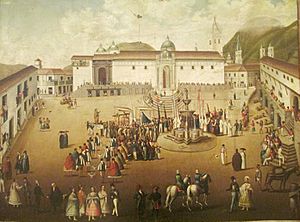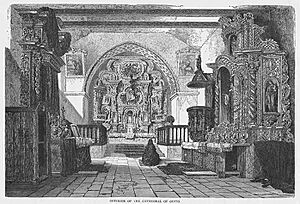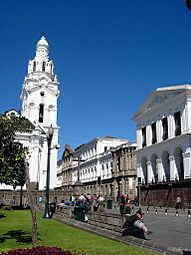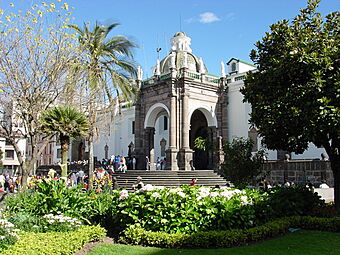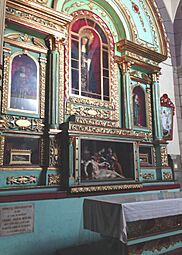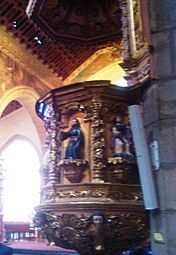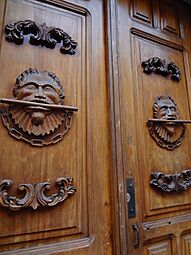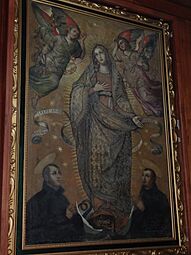Quito Metropolitan Cathedral facts for kids
Quick facts for kids Quito Metropolitan CathedralCatedral Metropolitana de Quito |
|
|---|---|
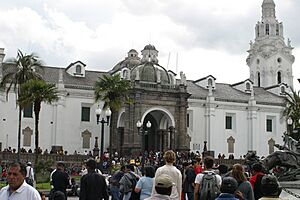 |
|
| Religion | |
| Affiliation | Catholic Church |
| Province | Province of Quito |
| Rite | Roman Rite |
| Ecclesiastical or organizational status | Metropolitan cathedral |
| Leadership | Archbishop Fausto Trávez Trávez, O.F.M. |
| Year consecrated | 1545 |
| Location | |
| Location | Quito, Ecuador |
| Architecture | |
| Architectural type | Christian basilical church |
| Architectural style | Baroque, Gothic-Mudéjar, Neoclassical |
| Groundbreaking | 1535 |
| Completed | 1799 |
| Direction of façade | Northwest |
| Type | Cultural |
| Criteria | ii, iv |
| Designated | 1978 |
| Parent listing | City of Quito |
| Reference no. | 2 |
| Website | |
| Website | |
The Quito Metropolitan Cathedral (also known as Catedral Metropolitana de Quito in Spanish) is a very important Catholic church in Quito, Ecuador. It stands on the southwest side of the Plaza de la Independencia, also called La Plaza Grande. This cathedral has been a key religious center for centuries.
It became the main church for the Diocese of Quito in 1545. Later, in 1848, it was made an Archdiocese. In 1995, it was named the Cathedral of Ecuador, making it the most important Catholic church in the entire country.
Contents
History of the Cathedral
Early Days and First Buildings
After the city of San Francisco de Quito was founded on December 6, 1534, the area where the cathedral now stands was given to the Church. The very first church building was put up in the same year by Father Juan Rodriguez. It was a simple structure made of adobe, wood, and a thatch roof.
In January 1545, the parish of Quito was officially created. A bishop named García Díaz Arias arrived in April 1546. He came with plans to build a much grander church.
Building the Cathedral
Construction of the current cathedral began in 1535. It officially became a cathedral when the Bishopric of Quito was created in 1545. From 1562 to 1565, the building grew from its limestone foundations. Pedro Rodríguez de Aguayo led the construction, as Bishop Diaz Arias had passed away. The architect was Antonio García.
Workers used stone and a local tradition called the minga system. This system involved people working together to haul materials, carve stone, and build. The cathedral was built with its side facing the Plaza. This is unusual, but it happened because there was a deep ravine behind the church at the time. This ravine, called la quebrada de Sanguña, stopped them from extending the building backward. The location was chosen for defense. The cathedral was officially blessed by the second bishop of Quito, Fray Pedro de la Peña, in 1572.
Changes Over the Centuries
In 1660, Mount Pichincha, a nearby volcano, erupted and damaged the cathedral. Bishop Alfonso de la Peña y Montenegro ordered it to be rebuilt. Many parts of the inside were redone. A famous painting of the Virgin Mary by Miguel de Santiago comes from this time. The building was also made longer, and a side door was added to the square. A separate building for meetings, called the sacristy or La Iglesia de El Sagrario, was also built.
Another earthquake in 1755 caused some damage, but it was minor. A bigger earthquake in 1797 led to major changes inside. The choir area was updated. It is believed that the artist Caspicara (Manuel Chili) helped with this work. The beautiful golden wooden pulpit was also redone around this time.
19th Century Enhancements
Between 1797 and 1799, the Carondelet Arch was added to the cathedral. This was a project led by Baron Héctor de Carondelet and designed by engineer Antonio García. The original ceiling, from the 1500s, was replaced with a copy in the early 1800s. Earthquakes in 1858 and 1859 damaged the bell tower, which was fixed in 1930.
The catacombs (underground burial places) of the cathedral hold the remains of many important people from Ecuador's history. This includes the independence leader Antonio José de Sucre (1795–1830), who has his own special chapel. On January 13, 1848, the Diocese of Quito became an archdiocese.
You can find a plaque at the small altar of Nuestra Señora de los Dolores (Our Lady of Sorrows). It marks the spot where President Gabriel García Moreno was shot in 1875. Also, the Bishop of Quito, José Ignacio Checa y Barba, was poisoned here during a Good Friday mass in 1877. Several other presidents, bishops, and priests are also buried in the cathedral.
20th Century Restorations
In the mid-1900s, parts of the ceiling and arches were replaced. The tall bell tower was repaired in 1930. After an earthquake in 1987, the city of Quito worked to strengthen the cathedral's deep foundations. In 1995, the Cathedral of Quito was named the Cathedral of Ecuador, making it the most important Catholic church in the country. More restoration work was done in 1997 and 1999.
Cathedral Features
The cathedral is a large white church with one tall bell tower on the right side of the main entrance. It has three long sections called naves, supported by arches and square pillars. The basic design is typical of churches from the 1500s. Some experts say the cathedral has a Gothic-Mudéjar style. This means it mixes European Gothic features with influences from Islamic art in Spain.
Outside the Cathedral
Unlike many Spanish churches, the Quito Cathedral has two main entrances. One faces the Plaza, and the other, with the bell tower, faces Calle Garcia Moreno. The church faces a certain way because of the land. Ravines in the 1500s stopped the main front from facing the plaza, which is usually how it's done.
The fancy arched side-entrance and its curved staircase facing the Plaza were added in the early 1800s. This entrance is called the Carondelet Arch. It's the main way people enter from the square. Three beautiful green domes sit on top of the church. The dome over the main crossing has an iron rooster weather vane, which is part of local legends.
Plaques on the outside walls remember important events. One celebrates the 400th anniversary (1934) of the city's founding. It also mentions that this site was where Francisco de Orellana started his journey to explore the Amazon River. Other plaques name the city's five founders and declare "Quito, Patrimony of Humankind."
Inside the Cathedral
Inside, the three naves are supported by pointed arches and square pillars. The central nave has a cedar wood ceiling with Moorish (Islamic) designs. This amazing wooden ceiling is decorated with a golden border and beautiful paintings. The right nave has several chapels along its wall, each with domes and skylights. These chapels include: All Souls, Calvary, The Denial of Peter, Saint Peter, and The Sacred Family. There's also a large carved wooden door leading to La Iglesia de El Sagrario, a 17th-century chapel connected to the main building.
Artworks by artists from the Quito School of Art decorate the cathedral. The side altars, covered in goldleaf, were carved by early masters of this school. They hold statues of saints. The large painting of the Assumption of the Virgin from 1793, located in the upper choir, was painted by Manuel de Samaniego. The altar in the Chapel of All Souls has a famous sculpture called The Denial of St. Peter.
Other important artworks include the Altarpiece (Retablo) of Santa Ana (from the 1700s), Bernardo Rodríguez’s Cure of the Lame by Saint Peter, and the 1734 sculpture Inmaculada by Bernardo de Legarda. There are also paintings like Adoration of the Three Magi and Cure of the Crippled.
The main altar is said to be made entirely of gold. It shows both Baroque and Mudéjar styles. You can also see works by colonial artists like Miguel de Santiago, Manuel Chili "Capiscara", and Bernardo Rodríguez. The central nave has a fresco (wall painting) with Bible stories. Further down, there are cedar chairs from 1794, painted and covered in gold.
-
17th-century Mudéjar ceiling of the main nave.
El Arrastre de Caudas Ceremony
On the Wednesday of Holy Week, a special ceremony called "el Arrastre de Caudas" takes place. This means "the dragging of the trains." It is said to be unique to this cathedral. The ceremony comes from ancient Roman times. In Rome, a banner was passed over a dead general's body and then flown over his soldiers. This was a way to symbolically transfer his good qualities to them.
This ceremony started in Seville, Spain, and then came to Quito and Lima. Today, it only continues in Quito, and it has been happening since the 1500s. During the ceremony, a long black cloth, several meters long, trails behind each of the cathedral's priests. They walk through the church as part of a larger procession that includes the archbishop carrying a piece of the True Cross. Another large black banner with a red cross covers the altar. The archbishop then waves this banner over the priests, who lie down on the floor, and then over everyone else in the church.
See also
 In Spanish: Catedral metropolitana de Quito para niños
In Spanish: Catedral metropolitana de Quito para niños
- List of buildings in Quito



